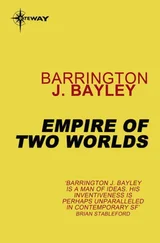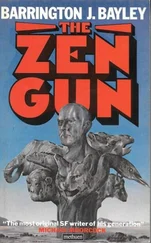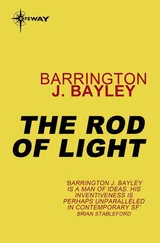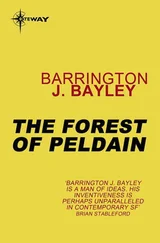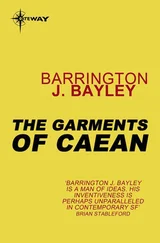Barrington Bayley - The Seed of Evil
Здесь есть возможность читать онлайн «Barrington Bayley - The Seed of Evil» весь текст электронной книги совершенно бесплатно (целиком полную версию без сокращений). В некоторых случаях можно слушать аудио, скачать через торрент в формате fb2 и присутствует краткое содержание. Город: London, Год выпуска: 2012, ISBN: 2012, Издательство: Gateway, Жанр: Фантастика и фэнтези, на английском языке. Описание произведения, (предисловие) а так же отзывы посетителей доступны на портале библиотеки ЛибКат.
- Название:The Seed of Evil
- Автор:
- Издательство:Gateway
- Жанр:
- Год:2012
- Город:London
- ISBN:978-0-575-10220-0
- Рейтинг книги:4 / 5. Голосов: 1
-
Избранное:Добавить в избранное
- Отзывы:
-
Ваша оценка:
- 80
- 1
- 2
- 3
- 4
- 5
The Seed of Evil: краткое содержание, описание и аннотация
Предлагаем к чтению аннотацию, описание, краткое содержание или предисловие (зависит от того, что написал сам автор книги «The Seed of Evil»). Если вы не нашли необходимую информацию о книге — напишите в комментариях, мы постараемся отыскать её.
, here is a second collection of endlessly inventive stories by Barrington J. Bayley; dark fables resounding with sombre undertones—love used as a weapon, God assassinated by the ingenuity of man, the secret of death revealed, the inexplicable explained! Tales which will be pondered on, and remembered.
The Seed of Evil — читать онлайн бесплатно полную книгу (весь текст) целиком
Ниже представлен текст книги, разбитый по страницам. Система сохранения места последней прочитанной страницы, позволяет с удобством читать онлайн бесплатно книгу «The Seed of Evil», без необходимости каждый раз заново искать на чём Вы остановились. Поставьте закладку, и сможете в любой момент перейти на страницу, на которой закончили чтение.
Интервал:
Закладка:
When the space rushed in, she began to sink. That is, she took on greater, more meaningful proportions, became more majestic. As more of her bulk was submerged, the enigma of her appearance was resolved, and at last she reached the point where she revealed her real shape to us fishes. There was a keel, now, and a curving bulge of prow, sides and stern. Even a steering oar became visible.
Slowly, the true nature of the vessel heeled over into the sidereal universe as currents of space swirled in and around her. And then, when she was totally submerged, I saw it—the open deck, the drowned crewmen, the great expanse of square sail. Then I saw the nobles which the ship carried: the poet-faced youth, with a golden circlet about his neck, a short dagger of authority at his side, and his arm around a beautiful lady, dressed in a loose flowing robe, her hair gorgeously arrayed, but both their faces relaxed now in the repose of death by drowning. Of course, they were about thirty feet tall….
Within a few minutes the ship began to break up. I saw a tiny figure struggling through the disintegrating bilges, and automatically flicked on the intercom to hear his hoarse gasping breath. Nothing amiss there. He jetted a short distance away and looked up at the lord and lady, a blunt midget against their gracious forms.
Immersed in space, their bodies dissipated, fading away in spinning particles, brief glimmers and spiracles. Even the ship itself had become water-logged—space-logged, and was shredding into fragments which dispersed into non-existence.
“Oh,” quavered Rim, “I’m a murderer.”
Ten minutes later there was only black, empty space on the view-screen. Rim clumped through the airlock and grumpily told me he hadn’t learned a thing about what it was like without space.
So we both returned to the bottle.
All that Rim put on his research report this year was: “Found a sailing ship. Sank it.” I hope we don’t lose our jobs because of that; we’d be pretty lucky to find another easy number like this one. Still, we’ve got beer enough for another three months, so we’ll find out then.
Actually, I think we’ll get through the beer in two months, or even one.
The other day Rim started laughing. “I just can’t get over it,” he said. “Creatures to whom space is a heavy liquid! I’d like to see their aeroplanes.”
“Yeah,” I answered. “What about when they get the idea of submarines?”
The Radius Riders
The last dive of the subterrene vessel Interstice began as a test mission to prove her worth. She had but recently been launched: half her galleries were empty shells, waiting to be fitted with munitions and crew quarters. Nevertheless, we carried a good load, a crew of two hundred, and our technical plant, including armaments, was complete. Two magazines, one fore, one aft, were stacked with torpedoes; and the whole mass lay sedately in the grip of the polariser fields, by means of which our newly-built ship travelled through solid matter.
The development of subterrene ships had only just begun, and the Interstice was the fifth of the species, the others being prototypes. We had built her large, and we had built her powerful, for she was a warship. As yet, our nation was not at war, but we had enemies, and underground travel was an advantage to be quickly grasped.
And so, with Captain Joule in command, and I, Ross, as technical officer, we undertook to journey across the American continent from east to west, at a depth of ten miles. We passed beneath mountain ranges, beneath deserts and lakes, and slipped through every kind of geological formation. We tested for speed, steering—a complicated process where atom-polarisers are concerned—and depth control. Throughout, the equipment did not falter. The polariser fields stayed solidly in balance, even when we turned the Interstice first hard to port, then hard to starboard. The first fully operational subterrene ship was a success.
We were jubilant. We had no suspicion, as we approached the west coast, that a grave misfortune was soon to befall us, provoking us into reckless folly and causing us to be caught helpless in the grip of the mighty terrestrial planet.
I was with Captain Joule in the control cabin when he gave the order to surface at our prearranged location. On an even keel, the ship rose steadily.
At seven miles, a high-pitched hum sounded in the metal of the ship, rising rapidly to an unnerving screech as we ascended. At the same time, an urgent call came from Polariser Section.
The white-faced image of the chief engineer stared from the communicator screen. “Captain! An outside force is distorting the field! We can’t hold it!”
“Dive!” ordered Captain Joule.
Down we plunged, and immediately the terrifying sound ceased. As the Interstice shuddered to a stop, Joule questioned the engineer.
“What sort of a force?” he demanded.
“It was magnetic, very powerful. The noise we heard was due to every metallic atom on board vibrating on its polarised alignment. Another half minute and the whole ship would have been unpolarised!”
“Just how powerful is it?” Joules asked, puzzled.
The engineer shrugged. “The meters went haywire. I don’t understand it! We never guessed there were such intense energies at only five miles.”
Joule paused. “Weapons Section! Fire a torpedo straight up; but don’t set the fuse.”
Moments later, the Interstice made the first use of her armament. The torpedo lanced upwards, traced by polarised-field detectors. Shortly after it passed the five-mile limit, the missile vanished from the screen, and we received a series of strong shock-waves.
The torpedo’s polarisers had failed.
Still Joule was not satisfied. He ordered us up once more. Cautiously, we approached the danger level, and the shrieking of vibrating atoms hummed through the ship. Following on the pleas of Polariser Section, we sank back to a safe depth.
Now our confidence was gone. Retracing our route, we tried again with the same result. Then we made periodic attempts all the way back to the east coast, and for two weeks wandered over the continent, probing. The unbelievably strong phenomenon lay like a blanket under the land.
Myself, I doubted that it was magnetic in origin. Most likely, I thought, it was a magnetic effect produced by a freak stream of particles which had begun to flow while we were submerged.
Captain Joule was gloomy when I expressed this idea to him. “In that case,” he commented, “it might be artificial. It certainly is an effective weapon against a subterrene ship.”
But whatever the origin, the practical fact remained: we were unable to break surface.
The mood of the Interstice changed as we realised this. The excitement of our successful new enterprise vanished. I noticed for the first time how hollow the inside of the ship was, how every sound produced echoes in its cavities, and how dully its arched walls reflected the yellow lighting. It was easy to imagine how far within the Earth we were. I looked at Captain Joule, and knew that he had the same feelings.
Suddenly, I roared with laughter. “Well, we are trapped,” I said lightly. “What of it? All the better. This is our chance to defy those faint-hearts of the Navy Department with impunity.”
“What do you mean?” Joule asked.
“They forbade us, in the interests of caution, to take any of our ships deeper than ten miles at this stage. But since we cannot ascend, we will return to the surface the long way—through the diameter of the planet.”
He smiled, considering the proposal with characteristic brevity. I remembered the previous conversations we had held over the years, when the polariser fields were undergoing their slow, painful development in the Navy laboratories. Many daring schemes such as this had suggested themselves to us, and we were only biding our time in order to carry them out.
Читать дальшеИнтервал:
Закладка:
Похожие книги на «The Seed of Evil»
Представляем Вашему вниманию похожие книги на «The Seed of Evil» списком для выбора. Мы отобрали схожую по названию и смыслу литературу в надежде предоставить читателям больше вариантов отыскать новые, интересные, ещё непрочитанные произведения.
Обсуждение, отзывы о книге «The Seed of Evil» и просто собственные мнения читателей. Оставьте ваши комментарии, напишите, что Вы думаете о произведении, его смысле или главных героях. Укажите что конкретно понравилось, а что нет, и почему Вы так считаете.


